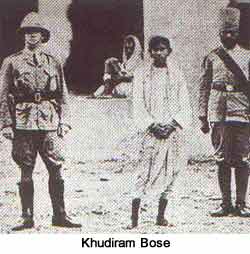

 |  |
 The end of 1907 brought another political trend to the fore. The impatient young men of Bengal took to the path of individual heroism and revolutionary terrorism (a term we use without derogatory meaning and for want of a different term). This was primarily because they could find no other way of expressing their patriotism. Soon this pattern of revolutionary terrorism spread across the whole country.
The end of 1907 brought another political trend to the fore. The impatient young men of Bengal took to the path of individual heroism and revolutionary terrorism (a term we use without derogatory meaning and for want of a different term). This was primarily because they could find no other way of expressing their patriotism. Soon this pattern of revolutionary terrorism spread across the whole country.
In 1904, V.D. Savarkar organized Abhinav Bharti as a secret society of revolutionaries. After 1905 several newspapers openly (and a few leaders secretly) began to advocate revolutionary terrorism. In 1907, an unsuccessful attempt was made on the life of the Lieutenant Governor of Bengal. In April 1908, Prafulla Chaki and Khudiram Bose threw a bomb at a carriage which they believed was occupied by Kingsford, the unpopular judge at Muzzafarpur. Unfortunately, they killed two English ladies instead. Prafulla Chaki shot himself dead while Khudiram Bose was tried and hanged. Thousands wept at the death of the 17 year old boy, and he and Chaki entered the ranks of popular natinalist heroes about whom folk songs were composed and sung all over the country. The era of revolutionary terrorism had begun. Very soon secret societies of revolutionaries came up all over the country, the most famous and long lasting being Anushilan Samiti and Jugantar. Their activities took two forms - the assassination of oppressive officials and informers and traitors from their own ranks and dacoities to raise funds for purchase of arms, etc. The latter came to be popularly known as Swadeshi dacoities. Two of the most spectacular revolutionary terrorist actions of the period were the unsuccessful attempt under the leadership of Rash Bihari Bose and Sachin Sanyal to kill the Viceroy, Lord Hardinge who was wounded by the bomb thrown at him while he was riding an elephant in a state procession- and the assassination of Curzon-Wylie in London by Madan Lal Dhingra. In all 186 revolutionaries were killed or convicted between the years 1908-1918. The revolutionary terrorists also established centers abroad. The more famous among them were Shyamji Krishnavarma, V.D.Savarkar and Har Dayal in London and Madam Cama and Ajit Singh in Europe. The end of this section |
Copyright ©2000 indiansaga.info. All rights reserved.
By using this service, you accept that you won't copy or use the data given in this website for any commercial purpose.
The material on indiansaga.info is for informational & educational purpose only.
This site is best viewed at 800 X 600 picture resolution.